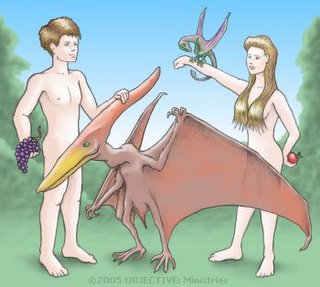The world is a mask that hides the real world.
Thatâs what everybody suspects, though the world we see wonât let us dwell on it long.
The world has ways - more masks - of getting our attention.
The suspicion sneaks in now and again, between the cracks of everyday existenceâ¦the bird song dips, rises, dips, trails off into blue sky silence before the note that would reveal the shape of a melody that, somehow, would tie everything together, on the verge of unmasking the hidden armature that frames this sky, this tree, this bird, this quivering green leaf, jewels in a crown.â¦
As the song dies, the secret withdraws.
The tree is a mask.
The sky is a mask.
The quivering green leaf is a mask.
The song is a mask.
The singing bird is a mask.
Sunday, December 04, 2005
wanted: good christian dino hunters
[....] I have also contacted "Johnny" Kimbuso, my African guide from my last expedition, to see if he would be willing to help. It was he who managed to take the picture of the apatosaur we uncovered. Hopefully, I can convince him to join me again on another Creation Science adventure, although he still suffers trauma from his close encounter with the charging dinosaur.
[....] Besides supplies that are common to all animal capture expeditions, we have determined that we need the following special equipment:
* Metallic pterosaur effigies based on Biblical designs (for herding into traps.)
* Frankincense smoker (to disorientate the animals for capture.)
* Nets, including large butterfly-style nets for use on smaller rhamphorhynchi.
* Calming hoods (designed based on Deluge-era pterosaur skull remains.)
* Reinforced bird cages.
* Climate controlled egg transport containers. [....]
What Are Pterosaurs?
Pterosaurs (ter’ə·sôrs) are flying reptiles with leathery or membranous wings attached to the sides of their bodies and supported by an elongated fourth digit on their forelimbs. They were created by the Lord on the fifth day of His Creation Week (Genesis 1:20-22) and were a constant presence in the skies over Eden, where they peacefully ate fruit and plants. After the Fall, many of their descendants degenerated to a carnivorous diet and became feared by man, although non-wicked specimens preserved on the Ark helped to temper this degenerative tendency after the Flood. Various Pterosaur kinds were common throughout Eurasia and Northern Africa up until the early Middle Ages and interacted extensively with Man. Today, although Evolutionists falsely insist that they are extinct, pterosaurs can still be found, hidden away in the unexplored wilds of our world.
There are two main baramins of pterosaurs: rhamphorhynchoid and pterodactyloid. Rhamphorhynchoid kinds are small to medium sized (usually no larger than a sea gull) with long tails, short heads and necks, and teeth. Pterodactyloid kinds are medium to very large (in fact, they include the largest flying animals that ever lived) with short tails, longer necks and limbs, often crested heads, and usually lack teeth. It's still debated whether these groups are monobaraminic or holobaraminic, and it is one of Project Pterosaur's science goals to answer this question (if we find specimens of both groups, we can determine baraminicity by using Intelligent Design Theory to measure their specified complexity and apply the Dembski-Shannon equation to extrapolate the amount of relative informational loss due to genetic degradation from their perfect Creation.) [....]

Pterosaurs, including the ancestors of pterodactyls (middle left) and rhamphorhynchi (middle right), lived peacefully with Adam and Eve in the Garden of Eden. (Artistic reconstruction by Peggy Miller.)

During the Exodus, Israelites within sight of Moses's brazen pterosaur-scaring device (pictured above) were safe, but many stragglers still perished from the persistent bites of the serpentine pterosaurs. (Artistic reconstruction by Peggy Miller.)




